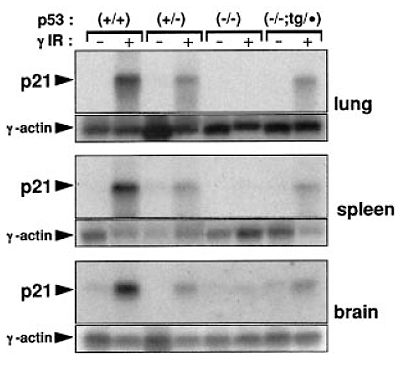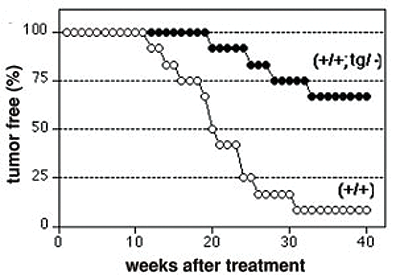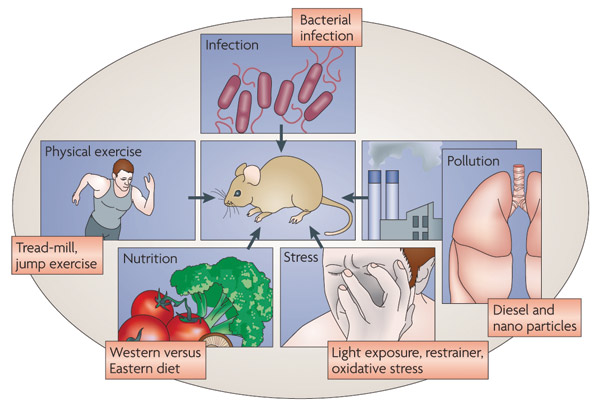Chapter 1. p53 Mouse Models of Human Cancer
Introduction
p53 Mouse Models of Human Cancer
Introduction
At first glance, mice and humans appear to have little in common. From a genetic, physiological, and anatomical perspective, however, mice are remarkably similar to humans. Indeed, comparisons between the mouse and human genomes have revealed that 75% of mouse genes - a total of 15,187 genes - have a 1:1 relationship with human genes and are predicted to share functions with their human counterparts1. Although the mouse and human genomes are not identical, they are similar enough that researchers can use genetically engineered mice to study genes linked to human disease. How are mouse models of human disease created? And how do they inform us about human disease?
One way to determine whether a gene contributes to the development of a disease is to silence its expression in a mouse strain. Researchers who do this in the lab are creating what's known as a "knockout" mouse model. Alternatively, researchers can introduce a wild-
Here we'll explore how p53 knockout and knock-
1.Church, D. M. et al. Lineage-
Genetically Engineered Mice and Cancer Research
The use of animal models to study human disease is vital to research because ethical and monetary considerations mean that most of these experiments cannot be performed on human subjects. In studies of cancer genetics, the mouse is the most widely used mammalian model organism. Considerable effort has gone into developing relevant mouse models of various forms of cancer to help pinpoint the genes that are responsible for cancer formation and progression. The knowledge we have gained by using mouse models cannot be understated.
Introduction to p53
Cancer is a class of disease characterized by uncontrolled cell growth or proliferation and, in the case of malignant cancer, invasion of adjacent and distant tissues. Tumor suppressor genes are a category of genes that suppress cancer formation. Some tumor suppressor genes encode proteins that repress genes essential for the progression of the cell cycle. Other tumor suppressor genes couple the cell cycle to DNA damage or initiate programmed cell death. Phenotypes associated with mutations in tumor suppressor genes are most often recessive, meaning that both alleles of the gene must be inactivated before a phenotypic effect is observed. One notable exception to this rule is the p53 gene product.
p53 (also called tumor protein 53, or TP53 and Trp53 in mice) was named "Molecule of the Year" in 1993 by the journal Science2. Why is this molecule so important? p53 is a tumor suppressor that has important functions in DNA transcription, cell growth, and cell proliferation. Because of these functions, p53 plays a critical role in cancer prevention. If the p53 gene is damaged or lost, the risk of developing cancer is greatly increased. Interestingly, certain types of mutations in just one p53 allele are sufficient to inactivate the wild-
2.Koshland, D. E., Jr. Molecule of the year. Science 262, 1953 (1993). doi: 10.1126/science.8266084
p53 Knockout Mice
Are mice that lack a functional copy of the p53 gene more prone to cancer? In 1992, Donehower and colleagues achieved the first p53 gene knockout in mice3. This team used homologous recombination in mouse embryonic stem cells to inactivate the p53 gene. Using molecular biology techniques (discussed in Section 10.6 and in pages 806-
The team monitored the p53-/- mice, p53+/- mice, and their wild-
3.Donehower, L. A. et al. Mice deficient for p53 are developmentally normal but susceptible to spontaneous tumours. Nature 356, 215-
p53 Knock-
If mice lacking p53 are sensitive to cancer, are mice with extra copies of the p53 tumor suppressor gene more resistant to cancer? To address this question, researchers have also made "super p53" mice4. Using molecular biology techniques (discussed in Section 10.6 and in pages 772-

Figure 1 Source: Figure 3 (Panel A only) from Garcia-
As an important control experiment, the research group first tested the "functionality" of the p53 transgenic allele by mating transgenic mice (p53tg) with p53 null mice (p53-/-) that lack both copies of the p53 allele and therefore have no functional p53 protein. They were able to show that these p53-/-;tg mice responded to DNA damage in a manner similar to p53+/- mice, suggesting that the p53 protein produced by the transgene is functional and subject to the same regulatory mechanisms as the endogenous p53 protein (Figure 1)4.

Figure 2 Source: Figure 5 (Panel A only) from Garcia-
Having established the functionality of the p53 transgenic allele, the researchers tested the tumor resistance of the super p53 mice. Exposing these animals to chemicals that cause cancer revealed that whereas in wild-

Figure 3 Source: Figure 6 (Panel B only) from Garcia-
These landmark mouse models were invaluable in helping researchers understand the complex functions and interactions of p53. Similar models have been created for myriad other cancer-
4.García-
What Limitations Should We Consider?
Academic researchers, clinicians, and pharmaceutical researchers use mouse models extensively, from basic research on human disease to preclinical studies. But while mouse models of human diseases represent an invaluable tool for scientists, there are a number of limitations we need to consider so that we may improve on existing models. For example, most human disorders are polygenic, meaning that a combination of alleles or genes is involved the disease. In contrast, many of the genetically engineered mice target a single gene (that is, they are monogenic). In addition, humans display far greater genetic diversity than do the inbred lines of mice used in the laboratory. Finally, the contribution of external (environmental) factors is rarely considered when evaluating the phenotypes of genetically engineered mice. Some of these environmental factors include diet, exercise, exposure to pollutants, and stress - all of which are tightly controlled and normalized in laboratory settings (Figure 4)5.

Figure 4 Source: Figure 4 from Beckers, J., Wurst, W. & de Angelis, M. H. Towards better mouse models: enhanced genotypes, systemic phenotyping and envirotype modelling. Nat Rev Genet 10, 371-
5.Beckers, J., Wurst, W., & de Angelis, M. H. Towards better mouse models: Enhanced genotypes, systemic phenotyping and envirotype modelling. Nature Reviews Genetics 10, 371-
Summary
Despite their limitations, mouse models of human disease represent the best mammalian model systems researchers have to work with. To date, mouse models have contributed an enormous body of knowledge to the scientific and medical communities. In particular, studies of the p53 knockout and super p53 mice have provided exciting new insights into the underlying causes and treatment of human cancer.
References
1.Church, D. M. et al. Lineage-
2.Koshland, D. E., Jr. Molecule of the year. Science 262, 1953 (1993). doi: 10.1126/science.8266084
3.Donehower, L. A. et al. Mice deficient for p53 are developmentally normal but susceptible to spontaneous tumours. Nature 356, 215-
4.Garcia-
5.Beckers, J., Wurst, W., & de Angelis, M. H. Towards better mouse models: Enhanced genotypes, systemic phenotyping and envirotype modelling. Nature Reviews Genetics 10, 371-
Quiz
Question 1.1
mlhrSGndU3ywL7hB7oQzkWxWYwjVqEGxqLPZqFA021g93KvxtSPS+jsCo6t+UwPSP8oLmGPcZT6ngYkSpzhkH26szjvUkNDL//ngkMSDbsY/rHe6JdnKN+uEP+U8BPR6R/QLNDPKMk3dj13cPsTERZsfIBgLoxJT9OyGqCpKJc3z/kt3Gnk2mOWIGAfTUlxfz+cUImNJ0qz3ORzWMkXMVhrJ66Da8xmaqMZi9imYjBtY7t4s3xfyRtHneiqfQ/FLjbq0kkDyBhMHggvSaWcqtCGuXAdyMkzsRWjlaHJvY/ToCrHdQ5zgdq7RPMm0Pb8srJpkpdlmRoDbusWGK/07LrBH+K/jd4RcnaeFq6UsV9nulKZNREwxrIzl3ux7yuBkT6TYp9msgukhH7xPKlA8oZjUSCJKuaGzsn1AR5gs6wOleQ2pxUF+S3uBGbchOZBqxbVQgqdFUykfrPA45HqzB/wLCfrTvBBEZ0pNTY+Wm5UAsm9YY9Q5i4sBxQ84rvaNShT9oVLm8WJl5kHdl9aoVT3eiPu7awHMRqQjwDcpD7+GWJGgtZCalZUMMErbpV3OwHTYzSgW31j5ntJxnLj1vnYVNEMRP3dPyYbFhx8P3WlEvyE844UwlaKQXcSVLLWNQocaIQ==1. Why do the researchers monitor the expression of γ actin?
Question 1.2
VKebag+3x7jH2BWrD5xxQsCB5uGOiVo2TsUHFkAR8WxRcfcAMuzabzIyJRoQVJHs3We06pDNpz9/67l+Mkz29VhO3XxXejI0vv5TszKnHAQyjD8ywmV9FFiE+NijbCTq2ziLuKaBjUgub0sY1ECqt+8CM8we3RZYuKjm2Ip85yw+26YfmekkD2gVAMpaOh7G2OhCzammafGanLS45/+ZcgEcqOWl9IpH3VxLn5l6yuKYKjFxklo1Gme/EFQM17aVfoQMH6X3uX4O30XAwSPwJkgWxBjFwu7hQsinMlw4VUmPhQFNNsNzYsloaAd6NW0uaLqOTYUuMfyZg7KIpIt73Yjn5D3+d0FdpzNAC6V1sL2i/NI7Is3LGNsdIbo2PhjndoHSMM4hJRrNN1XqnUUxO3kbcEFXFxbsEI/ODIJbuLE=Question 1.3
yCJT2vz9sesg4KKqff2WYWcvCjEsfv2Y0hxVYIfXoq/fFpZ6ojM3cMwT+5NUW408V+kiLqYvmCQZgBuDHyCRp1I20W+zsvbXdSPgaZZeDPSdKHd7g801iYaYTgk7Z1UWKAm1fS7Ti78c3rC+jUlndHK30D18dj1zAwBiWLLIXtEPhA+LybKOoZTE1RCdPhcctEvFek4huPa6hGmEtoql4xmaBtg2Q9CM60ebh6PpAbWQZh+MDnTFF95MBgK07fe5tsPeB1ar41SlTa0afX3V/iA3Q+9gBsi0LVnIjnfww94ZYmqSGTObLbj7IQyrc56BOzQHD+JlCYx9JNe3rvM97etoepZJ6eyfIxGcCt5BqXj6yTjJrwl1jSWKmoyzGTtryhMviR/EXrGPQaU0jwmAgSCmXMz/F/8pB2bzaEssDStX82lW+Z0FVqWpO6FuXpxscUbS6nTu1qy9AORV53mJDHhdbS1zhQca6tpvmWxqQobdUnQ6MltGeAakjM79AGRVhGBbqS+IEU+W+TEod7aN8Q==Question 1.4
nqqo/23Gcla9bfX3YBGU5Yx/MnMhfZ2DLsU/rnYC0Sx/0v61VwyYVsAXOp/lTWcRhfZgJieFEBiFpGGtiZq0iagknSTqAV40GmAE3y7vc5Qob2JQubZXUVp/g8sNeIZatbj7GdnO9kuCq++r24YRqq+IRI7Mkb/t71ccADs+jMMhTXjaSmcEs3DapV1NBUBU2IfFhKJgHTzr2Jk5zcHmkwvy8OxeXEd9FtEWRYDGbrP/rzcYHVgZ5bLz4vDf3hGOXkP8dcNMNo4SV7IIMLNB0BeVnnAhgxnDVtSLz+6Lu4u6ncAU+Q2nySreuAlMZNtOaPTHgx3ydntcC4GZheT/RjvbeLZydgYm2AXGowZ4TGtBJICN7SwW704pledRkNSU2EghkfOfrP/Q5sjC/bALEW0HO2MXHdUFCtHxhWfNHvG08QhR0XenMZyKTzkKTgolhgwgF8QFepOAB1lPNxN2+4QgHJuiabk+ULCutKb4rgO36ZHnuFtqC1KWCb2qzoHD+PBnGfZQiAPrnLLMAJrPthFM/986Ha3+qocjycxXqeIu6uw6F6RXFC03k2TMFqjVCmzNo1xv6I6RBM6WLd4Diw2ncgzWF8o+RJi0/q2dPmOixOMuPEPLl9LtAxRw+yio9Yga0TvpQ/2BwYhJLKG9lpTTMtIrIeJBxNbLx0/12GxKYdMWc7lwV9kPkcq6M0euLt9muX6Mfo8SEjgx5w8deuwOFeMAIN3ctPLK4wgzDCbxh5NTBVRTlIS6nH95a1hnKXB47X7QNS80e3o1iycfcJwq2LoxBkTHDlYQteLUURN/fqGJozpWNEBxysuErmfeK6ljcQ==4. We can conclude that having an extra copy of p53 protects animals against exposure to carcinogens because:
Question 1.5
HkeACYOL4mXHpFgdK6HDrs/oVkJPUr98yDuwcHD1vuLWD9efhQ3D2Lj05a/LC2LUESq5CjlBgSHWJsXyQkGfp0Suzcv/PkTADev4OCiYpoqtJ/4mi9mtoxCZmziqoG6Dcp7aVXzT91oWlCDCGYUkW6cD/N9gH+E9+F/uYTzYBoGleDYayEuzhJxRaz0P6Hx6f8Kfy+vEZmOuQrw9EC6OLu19Q0YVuqloNeCKjsvAloUumAealxIolzeuNsw6GAbHkWgtxwkvtlNP/YG8Bd/RBr7ydhcd081DHiClNO5XVhoh3akKSgJS4D4xC8qbjoKEVWwQxKxvzdZlSf1b0W1ihdTkvPPfUMUYbJA1a5Obxc/KJ5Do+GCRp1LVzMZdImr/4FRt/T52qowhArPcBtSZV0Py1p765rUaQ/cw3z6e+It2f2NjfrNAWrQ49UmTN1QiptHBOXrPRMd6ROYFpN6l4l43mxDLITArIZ/qEwyFeTPaNm4r8I6SODdsSMTiF0NUr91hlwY7RCYKezy6jEOtsRT3lXn5U9MIWcrkO7qP9V7UztzEicemJk25uUy3S+yVF7TWhCL6EfPbxzapqX9S1gHuEVt5ErL9mgEjSnfQY3Q8KhyMgEhRxk3dEBPMdYPP87O530nmD1b9fRPIHxXuHhqm/f2k31GuH6ldzfon7IBEDpTUPLxkU7IUTLUMqhz6ra51NwbfJvKq1Js53U6dEt1N5v8pVuqCb0JLwjmg+3ojXRTZrdBuAStuh2eH0aXqqDidV5rSvdhGJdN7ry+cqD11nakxkd4JxD+6gwQL4sRedY8G4cXPQnfTnDO6NgXg4i3YGC7/+zED2HinCzcq3Y0PI7yoF7Ox/N4P+VyXyfq59kAwufkp0K6Oouo=5. Which of the following statements is incorrect?
Question 1.6
cDliajBthwNxWuh3jjk8CoRp9CwvrtWkoE4vcdObUw08Yia0xQ1xmuSBMnp0S7ElN6FSCJ2zEzRGj4N0BXo5Qtv/gky6FMODZc1iuoq30l7+xeB/vyvwdhxauW+GS3QrWMKlB/FyjwXm/vQaP2c4X2rclk1GSW4bEOcgkBaWzj7pOguLcjpVotJuwWnhnTjbXDnJrtoNbLE9CqOExp0LmOneyDriVB37Vxs+Y6/o3LQBpRHyCXLg4lxwZMacxNXzhAt05tv00FNRLxCLBjzqxfC1J4fqqGo2FIAZsQNPcIeAvVKR78o0DdZDkCa9E3be9M7GCeiRsbwM8i1uMXGgcj4RIqAJdnfdwiYAg7og6NQtSmjSPWJEzmri7dOxDz/2wamOyKRvsK5aA6lsvWte/QCz//1b0URx8BXVogfvAJ96MBspjcqRsRetoh7DQcRcfSaNbpcTqizI8ae+cZOfEM/cHY1RJWR94Qg1COMqra8m+3XN9TZrtLeGSU3XHFawSG9pM/3vJIinrTr8sXFnJrs/R3A01azoGRWBCumjnisPXOd7HJFOdl8JZnzOs68bVrmwSh3etZeyUz8uYr25fJWoXg274cy26UcZzwvzbcCKKOgw7PIuRoc4/ldmaWINMayLqoieLwEXsL++KMq4J4+ECjIG1EGteJillqYm6u3t3zSdZ6xBoFNtS+iCMZAe9jaZjFSAtjqt+q7O7sBNzLkR+GxSFvTuQlaVyUO62fEF6Lp+GdHqW/1VoCClCap6S/Xo0e97gUOWq8uqOFNn/5YO7UfZpLalDgK8BElP4eElOgakxUObgUxhG6TB1T7qTbnIWopjXG5+eoWp233shTrd3oF38ABYOjsxXdIiZbWa7jstFicFsVS/wMZX7uSOi1i2/SuolWsv3OIuNhJruHkZ8o1OVzB8LXEhi0mvtGfTdatnAbaNX7eO5HjT7rhaS838unqtVoosH1P55ME9/FyvqwoON6VJriA+hyd7WNrNvlqRPclziiUR6SxuIKxMedGxmVxIbn7H4LcK4mH5ZCBp0NVB784+CK8zxd+S/S5dqElz+TJgsnlMbDCLSO8oLDA/jTZkvizRi3jqcQLw9S3LODHaBvBYEq+cZBw1nRLbfmn9wv4796OAoizKW0ZW2Rc2WV8/kBcSXRg5qjc4QatbkAqTJuCtEJecPj8c1mj4W4a16VAwueeMzYxIc8/eWcBCQhbIskgJz3wp8N5XHDdsU6dCN9oGPmqaPDFbd4hnWuXpHjzIpte9d6EQceNWQPlJyoyL3YssW7FJpnokef12iTRRDTrABYR/y2Nb/KNLuI4LB4PD+RrKNqr5ZPNYFdU6AjpWsv4xfze2lxDEjhB0JiMf+cCoHQS4IHjiEAP0OUbh/pHCc0HFY8Snebv2WOTg5bwwcqpf0b06F8x8+mva85gUKJW0PAbxf0HTBgLMI2LIks25JT8DbnTYOAf3/On5WqcfDCe6z4exf1lDdAqmmOJJJfQWxvXv4DmtAYDR7ftt5Lh4MbFCnA7251szKcbTc2NovJ9x5Y0ac/Ulci/CZ1Bjy6kE9/I7kBuoWaZoIpN373TGCwrH05Z2M1YcN9gu0okqSxHISStWTm9dN3iIXFwFpLBeCYHVgP+DaLCakImdzcfN2fNAPSbZ7vtGzccLWxj2is6zLLaTZnwAchh2X5nBVQOTfdCb+SMXR4tDB4HObcb+Vrfes2+X0O6u+EeuZ58zl+SMF8MZ4my6qE4D4P3pYHdf/KEYFsUhJ3CXhJokFsDpQcSegO8k3aPlq4Sivc7EOcJJBHvaJUNOJ/P0LgOaDGngAlUNA9vFxy8I13uk9VNbyOBJURZSxTAeEvwfXuSubaXNl5urqJdwV1x3A34DwSn0oEn9LDALNB2dU/9jKPGMcNpMBnZYA1eG1Ii4KAchR7w9G1IbiyKLB0gFn0bnOF5YciBO+B0TItz46icMpxiRZeED+Vr55zj8tZe9stdntvTjZthJ7+rpHT4Hz5a/IEDYcVay72ND3hr/TpVdLi6pwO4tKuRB5E5ZE3xPMakUKZyBeyCWINrCFpiT4UM8av4jtIz9QvXuIibHsfedGg8Y3BSvjmz04cmNgMbAEij+0SJPNLP6E+9I8b0VhAVQDl9U+1JIoKxJq57DS+w5QXEcMaIL7ZhbbjeR3dLwk1sDkp0KTTXT+53uen1SbyQbgh5v14TZFwaPM0vczzprK4/XfgnUkWeLz1RA8KK+tUmCqXydX0vfBlULB7zdl5jUp/KtduiNaoPyzHiEO0thfPQ/Jz4vFvwDW8QA1wgKXPSvRAN2OYqO21jmZ0Gu22hDXpLthoQI3A1GClJe4D2WSL9cTkZoSfa7XBxl+1I3oeXB26RtyFCL7++5xWBObmwP5MqlfF8tGLxGxM6/HDAdQKZYCK382zIn50a46PehiT2EMRkqrhQH6KghFc6ICc5kheZ+OTw31Tpdm0hBd7sMa9dfsIaZfimX7PI0IgygviYXYm3ut2s7FWk4qEp5nlsX1dF0UiNz48J4l9l7micEE+ifM+TlLp81tF1J5bJ+tefQAE6n66+6l/MOL4Ht21G1Gc1pOUvj1sUpuJCeD7kQkQ9mT51eRA2WtQANvURC6Zb/ozq0RSqsYdDQR17ALL9B5aPXT3OP75xmoiSuqHAA0a+PKniR53C0Nx2i769UzDqvxJv7khIVxYCANOdv16DR/aE7uwbJMp0SUxDkfsXZ8pbj340RM9EHeR9vGjRpiZwDmUmEJJvS1BlTTjvBE9vwTsmENaeMRPZ6RJKdO4t8sec+tVt8deA+tvTDdKVo2rCyzSwVj0PltTNo4uilf53Lg+Al4xR6/8zTebuXxPMR4ONSGPV04/9m0C856V/2FzFA/6LBx0ZSnnapmDhtzTXOuKwK7RFHSk5TFiI5+AyjoVX8/J3XtSDuy08mW7aIp5SlVMHefZ4GzDLoXtJHbHCB04kB83Hk/lOKCcxxQd3U3VLYIV1coROKbxEmtwxIerznPRY71BJNrJg/7GgjQDOz6QjQKRZAbUlQAOoBL4GiH7sRje1C0zBSdmdHFnAx9D8HuBzSCvmmOUTYiWoiE0MpuRzoB+g5C1zbtMPmx1VktfUgEtdR2vVoKU7bXyP66CFPVt5+Np+qHOAJPkDhYMBkf5Z5y4NZCH79fZdRvKAI3E49vVjly30WzWVUUL2qiQsovtyvKXWnRIMiKdo/5P1dgEMZg7/Z/Ldmsb6C4C/0tMWL8mPjZ8vSwjPU1xjok8mhnMzhQf2KSXfi0V3iuLhyIrEVIgpX9VhDj/cFeSsfrikWtInVdvV1Onvq9JTSC/HNadhFxMQhKRRiUENwnrIG5WdcPzqMRYx+x92+okXyZLl++d1pByzdmUkcNUe7fcYs3wKav6/lfpxxek1i04WD+l3C0xnRVj4SH3GULhuEL87d4GbFbCbkt6jOPoBEFsRNPu8cO4gRUJdQz19PxYzXLGAZtiS+qKNbIeYgYh0VffsW/iWzhY4cghCDExQghpsUSiLuXs2buSKQNzFSzWD06FAryS1xyeR0Nzqt7NkCePG+KNkU0/t2o+TXhYLmNXb44SnziMLtoT2b+g==6. Spurred on by the current media hype about 'super foods', you decide to use a mouse model to test if pomegranate juice might have different effects on cancer susceptibility in different genetic backgrounds. You are able to obtain mice from various sources and raise them in controlled environmental conditions. Mice kept in lab conditions are typically fed corn or millet-based food, supplemented with defined amounts of carbohydrates, fats, proteins, vitamins and minerals. You are able to modify the food with specific amounts of pomegranate juice. You are able to monitor different groups of mice, raised on regular food or pomegranate-containing food, to determine the spontaneous rate of tumor formation. Which of the following experimental conditions would best allow you to assay the protective effects of pomegranate juice in different genetic backgrounds?